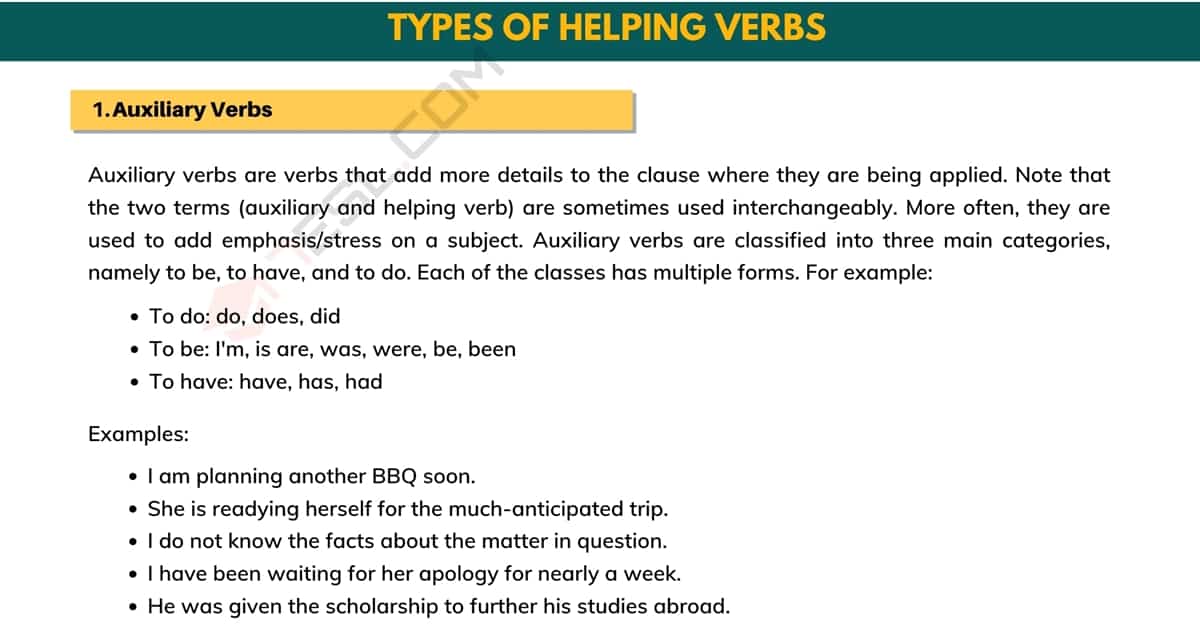What is a helping verb? As the name implies, helping verbs support the main verb in a sentence by adding additional meaning. These verbs are sometimes referred to as auxiliary verbs. Helping verbs typically precedes the lexical verb (main verb) in a sentence. When used together in a sentence, they form a verb phrase.
Helping Verb
What Is A Helping Verb?
Helping verbs are verbs that help elaborate the main verb further in a sentence. They can also elaborate on how time is conveyed in a text. Consequently, helping verbs are used to form the most complex sentences in English. Besides, these verbs help deliver intricate slight differences between words like probability, potential, etc.
Helping Verb Examples
Helping verbs are pivotal because they are necessary for the formation of a sentence structure. They are designed to support the main help by explaining it further. Helping verbs are classified into two categories, namely auxiliary and modal.
Auxiliary Verbs
Auxiliary verbs are verbs that add more details to the clause where they are being applied. Note that the two terms (auxiliary and helping verb) are sometimes used interchangeably. More often, they are used to add emphasis/stress on a subject. Auxiliary verbs are classified into three main categories, namely to be, to have, and to do. Each of the classes has multiple forms. For example:
- To do: do, does, did
- To be: I’m, is are, was, were, be, been
- To have: have, has, had
The verbs “be, do, and have” can be either independent or auxiliary. A verb is termed auxiliary if it is linked with other verbs to form a verb phrase.
Examples of Auxiliary Verbs
- I am planning another BBQ soon.
- She is readying herself for the much-anticipated trip.
- I do not know the facts about the matter in question.
- I have been waiting for her apology for nearly a week.
- He was given the scholarship to further his studies abroad.
Modal Verbs
Modal verbs are helping verbs that execute other specific tasks to elaborate on the meaning of the main verb. Examples of modal verbs include can, will, may, would, must, might, shall, should, could, ought to.
Modal verbs help in showing likelihood, responsibility, and necessity in a sentence. Examples of modal helping verbs in sentences:
- John can play football for most of the day.
- You should take a ride to relieve stress.
- When it is your turn, you must leave.
- I may not make it to the meeting.
- Would you mind if I come with my laptop?
Helping Verbs
Functions of Helping Verbs
As said earlier, helping verbs help express a slight meaning of words or phrases that may seem confusing due to their similarities. To demonstrate this, let’s explore the following examples:
- I may buy a car soon.
- I must buy a car soon.
- I should buy a car soon.
- I can buy a car soon.
- I will buy a car soon.
From these sentences, it is evident that modifying the helping verb alters the whole sentence’s meaning. In this case, the main verb “buy” alone cannot express the differences in sentences and thus the need for helping verbs.
Additional Functions of Helping Verbs
Helping verbs can help further express different conditions. For example:
- If she could run, she would emerge the winner.
- You may watch this fantastic series. In this case, the helping verb allows one to express permission.
- He can play football very well. In this case, the helping verb “can” demonstrates the ability to do something.
Helping verbs also help us to pose questions. For example:
- Do you think she is concerned?
- Will she emerge as the victor in her class?
- Do you think he will make it in life?
Changing Active Voice to Passive Voice
If we have an active sentence in the past tense, then the whole verb in the passive state will be in the past tense.
James built the table → The table was built by James.
- James is pushed to the end of the sentence, and the prepositional phrase is by James.
- The table moves in place of the subject.
- The helping verb “be” is introduced before the main verb.
- Past tense indicator shifts off built and onto the auxiliary verb be.
- Helping verb conforms with the new subject.
- The main verb built transforms into its past participle form “built”
Helping Verbs | Infographic










0 Comments